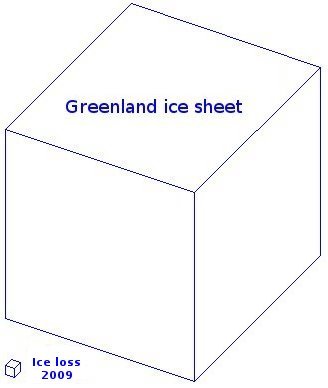
What The Science Says:
Multiple lines of evidence indicate Greenland's ice loss is accelerating and will contribute sea level rise in the order of metres over the next few centuries.
Climate Myth: Greenland has only lost a tiny fraction of its ice mass
'Greenland is losing about 0.007% of its total mass every year … seven thousandths of one percent lost annually, be still, my beating heart … And if that terrifying rate of loss continues unabated, of course, it will all be gone in a mere 15,000 years.' (Willis Eschenbach)
A number of independent lines of evidence show that overall, the Greenland ice sheet is losing ice. In fact, the rate of ice loss is accelerating. In light of this unequivocal evidence, a follow-up argument is "okay, it's happening but it's not so bad. Greenland is losing 286 gigatonnes of ice per year? There's around 3 million gigatonnes still remaining in the huge ice sheet."
In On Being the Wrong Size, Willis Eschenbach argues that Greenland is losing about 0.007% of its total mass every year. At that rate, it will take 15,000 years to dissipate. Here is a visual comparison of 2009 ice loss to the total ice sheet:

The important point to remember here is that ice loss is accelerating. In 2002, the ice loss was 137 gigatonnes per year (Velicogna 2009). At that rate, the ice sheet would take nearly 22,000 years to dissipate. By 2009, this rate had more than doubled to 286 gigatonnes per year, reducing the ice sheet "lifetime" to 10,500 years. As the rate of ice loss increases, the ice sheet's lifetime is also diminishing.
So the crucial question is how will the Greenland ice sheet behave in the future? There are several different ways to approach the problem. One method is to study the physics of glacier movements. One paper calculates glacier dynamics factoring Greenland's topography, the cross-sectional area of its glaciers and whether the bedrock is based below sea level (Pfeffer et al. 2008). Including contributions from Greenland and Antarctica, the study estimates global sea level rise between 80 cm to 2 metres by 2100.
A semi-empirical technique looks at how sea level and global temperature have changed in the past (Vermeer 2009). Sea level change can then be expressed as a function of temperature change and future projections of global temperature can be used to simulate future sea levels. This method predicts global sea level rise of 75cm to 180cm by 2100.
Climate modelling of the Greenland ice sheet predicts eventual collapse of the Greenland ice sheet if CO2 levels go over 400 parts per million (ppm). We're currently at 392 ppm. At 400 ppm, they predict that over the next 400 years, the ice sheet will lose between 20 to 41% of its volume (). This is equivalent to roughly 1.4 to 2.8 metres of sea level rise just from Greenland.
Lastly, we learn much about how the Greenland ice sheet behaves by looking at sea level change in the past. The more optimistic IPCC emission scenarios predict warming of 1 to 2°C. The last time temperatures were this warm was 125,000 years ago. At this time, sea levels were over 6 metres higher than current levels (Kopp 2009). This tells us the Greenland and Antarctic ice sheets are highly sensitive to sustained, warmer temperatures and are likely to contribute sea level rise measured in metres in future centuries.
The vast amount of ice still left in the Greenland ice sheet is a vivid reminder of Greenland's potential to contribute significantly to sea level rise in the future. And multiple lines of peer-reviewed evidence, both modelled and empirical, all paint a similar picture. The Greenland ice sheet is highly sensitive to warmer temperatures and is likely to contribute sea level rise in the order of metres over the next few centuries.
Intermediate rebuttal written by John Cook
Update July 2015:
Here is a related lecture-video from Denial101x - Making Sense of Climate Science Denial
Additional video from the MOOC
Interviews with various experts
 |
The Skeptical Science website by Skeptical Science is licensed under a Creative Commons Attribution 3.0 Unported License. |